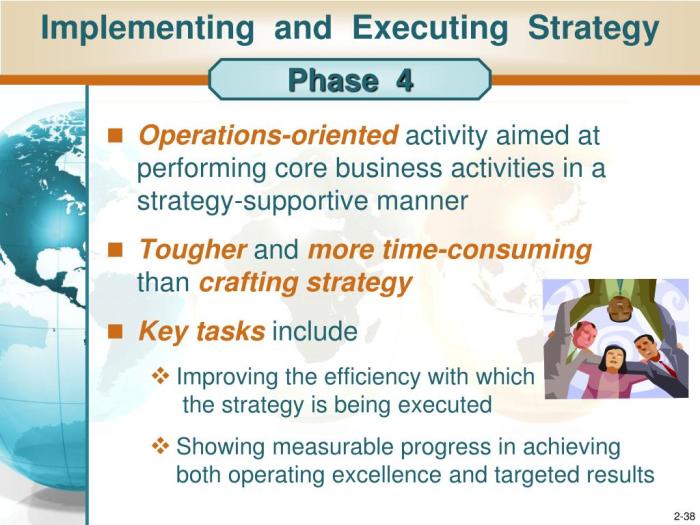Implementing and executing strategy successfully requires meticulous planning, effective communication, strategic resource allocation, diligent execution, and continuous evaluation. By adhering to these principles, organizations can translate their strategic vision into tangible results, driving growth and achieving their desired outcomes.
This comprehensive guide delves into the essential elements of strategy implementation and execution, providing practical insights and best practices to empower leaders in navigating the complexities of strategy realization.
Planning and Preparation
Thorough planning and preparation are crucial for successful strategy implementation and execution. This involves defining clear goals, identifying necessary resources, and establishing realistic timelines.
Key steps in the planning process include:
- Defining specific, measurable, achievable, relevant, and time-bound (SMART) goals.
- Conducting a thorough environmental scan to identify opportunities and threats.
- Developing a detailed action plan outlining the steps required to achieve the goals.
- Identifying and securing the necessary resources, including financial, human, and technological.
- Establishing realistic timelines and milestones to track progress.
Communication and Alignment
Effective communication is essential for aligning stakeholders and ensuring everyone understands the strategy. This involves clearly communicating the strategy’s goals, objectives, and implementation plan.
Methods for communicating the strategy effectively include:
- Using visual aids, such as presentations and infographics.
- Holding team meetings to discuss the strategy and address questions.
- Providing regular updates on the progress of the strategy’s implementation.
- Encouraging feedback and input from stakeholders throughout the process.
Resource Allocation and Management

Effective resource allocation is critical for supporting the implementation of the strategy. This involves allocating resources strategically to ensure that they are used efficiently and effectively.
Tools and techniques for managing resources include:
- Project management software to track progress and manage tasks.
- Resource allocation matrices to optimize resource allocation.
- Budget tracking to ensure that resources are being used as intended.
- Regular reviews to assess resource utilization and make adjustments as needed.
Execution and Monitoring

Execution involves putting the strategy into action and monitoring its progress. This includes setting milestones, tracking progress, and making adjustments as needed.
Key steps in the execution phase include:
- Setting clear milestones to track progress and identify potential roadblocks.
- Tracking progress regularly using performance metrics and other indicators.
- Making adjustments to the strategy as needed based on the monitoring results.
- Communicating progress and any adjustments to stakeholders.
Evaluation and Learning: Implementing And Executing Strategy Successfully Requires

Evaluation is crucial for assessing the success of the strategy and learning from the implementation process. This involves collecting data, analyzing results, and making recommendations for improvement.
Methods for evaluating the strategy include:
- Conducting surveys to gather feedback from stakeholders.
- Analyzing data to measure the impact of the strategy.
- Holding debriefing sessions to discuss the lessons learned.
- Using the evaluation results to inform future strategy development.
FAQs
What are the key steps involved in planning for successful strategy implementation?
Thorough planning involves defining clear goals, identifying necessary resources, developing realistic timelines, and conducting thorough stakeholder analysis.
How can communication contribute to effective strategy execution?
Clear and consistent communication ensures that all stakeholders understand the strategy, their roles, and the expected outcomes. Regular updates, visual aids, and team meetings facilitate effective communication.
What is the importance of resource allocation in strategy implementation?
Strategic resource allocation involves identifying and securing the necessary resources, such as personnel, funding, and technology, to support the implementation and execution of the strategy.
How can organizations track and monitor the execution of their strategy?
Regular progress tracking, performance metric analysis, stakeholder feedback, and periodic reviews enable organizations to assess the effectiveness of strategy execution and make necessary adjustments.
Why is evaluating the success of a strategy crucial?
Evaluation helps organizations determine whether the strategy has achieved its intended outcomes. It provides valuable insights for learning, improvement, and future strategic decision-making.